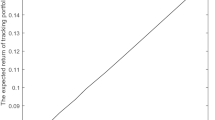Abstract
Index tracking problems are concerned in this paper. A CVaR risk constraint is introduced into general index tracking model to control the downside risk of tracking portfolios that consist of a subset of component stocks in given index. Resulting problem is a mixed 0–1 and non-differentiable linear programming problem, and can be converted into a mixed 0–1 linear program so that some existing optimization software such as CPLEX can be used to solve the problem. It is shown that adding the CVaR constraint will have no impact on the optimal tracking portfolio when the index has good (return increasing) performance, but can limit the downside risk of the optimal tracking portfolio when index has bad (return decreasing) performance. Numerical tests on Hang Seng index tracking and FTSE 100 index tracking show that the proposed index tracking model is effective in controlling the downside risk of the optimal tracking portfolio.







Similar content being viewed by others
References
Artzner, P., Delbaen, F., Eber, J. M., & Health, D. (1999). Coherent measure of risk. Mathematical Finance, 9, 203–228.
Beasley, J. E., Meade, N., & Chang, T. J. (2003). An evolutionary heuristic for the index tracking problem. European Journal of Operational Research, 148, 621–643.
Canakgoz, N. A., & Beasley, J. E. (2009). Mixed-integer programming approaches for index tracking and enhanced indexation. European Journal of Operational Research, 196, 384–399.
Clarke, R. C., Krase, S., & Statman, M. (1994). Tracking error, regret and tactical asset allocation. The Journal of Portfolio Management, 20, 16–24.
Coleman, T. F., Henninger, J., & Li, Y. (2006). Minimizing tracking error while restricting the number of assets. The Journal of Risk, 8, 33–56.
Krink, T., Mittnik, S., & Paterlini, S. (2009). Differential evolution and combinatorial search for constrained index-tracking. Annals of Operational Research, 172(1), 153–176.
Kwiatkowski, J. W. (1992). Algorithms for index tracking. IMA Journal of Mathematics Applied in Business & Industry, 4, 279–299.
Lobo, M. S., Fazel, M., & Boyd, S. (2007). Portfolio optimization with linear and fixed transaction costs. Annals of Operational Research, 152(1), 341–365.
Markus, R., Wolter, H. J., & Zimmermann, H. (1999). A linear model for tracking error minimization. Journal of Banking & Finance, 23, 85–103.
Moral-Escudero, R., Ruiz-Torrubiano, R., & Suarez, A. (2006). Selection of optimal investment portfolios with cardinality constraints. In Proceedings of the IEEE congress on evolutionary computation 2006 (pp. 2382–2388), 16–21 July 2006.
Ogryczak, W., & Ruszczyński, A. (2002). Dual stochastic dominance and related mean-risk models. SIAM Journal on Optimization, 13, 60–78.
Pflug, G. (2000). Some remarks on the value-at-risk and conditional value-at-risk. In S. Uryasev (Ed.), Probilistic constrained optimization: methodology and application. Dordrecht: Kluwer Academic.
Rockafellar, R. T., & Uryasex, S. (2000). Optimization of conditional value-at-risk. The Journal of Risk, 2, 21–41.
Rockafellar, T. R., & Uryasex, S. (2002). Conditional value-at-risk for general loss distributions. Journal of Banking & Finance, 26, 1443–1471.
Roll, R. (1992). A mean-variance analysis of tracking error. Journal of Portfolio Management, 18, 13–22.
Ross, C., Terlaky, T., & Vial, J. Ph. (1986). Theory and algorithm for linear optimization: an interior point approach. Chichester: Wiley.
Ruiz-Torrubiano, R., & Suárez, A. (2009). A hybrid optimization approach to index tracking. Annals of Operational Research, 166, 57–71.
Shapcott, J. (1992). Index tracking: genetic algorithms for investment portfolio selection (Technical report, EPCC-SS92-24). Edinburgh, Parallel Computing Centre.
Sharpe, W. F. (1971). A linear programming approximation for the general portfolio analysis problem. Journal of Financial and Quantitative Analysis, 6, 1263–1275.
Ye, Y.Y. (1997). Interior point algorithms: theory and analysis. New York: Wiley.
Acknowledgements
This research is supported by National Natural Science Foundations, P.R. China (Grant No. 10971162, 11101325 and 71171158).
Author information
Authors and Affiliations
Corresponding author
Appendix: A hybrid genetic method for index tracking problem
Appendix: A hybrid genetic method for index tracking problem
Ruiz-Torrubiano and Suárez (2009) propose a hybrid optimization approach for index tracking problem, where the tracking error is measured by mean square deviation between the returns of the tracking portfolio and of the index. The resulting problem is a mixed 0–1 quadratic programming problem. The approach has been tested on different practical data sets. It can effectively solve index tracking problems. A hybrid genetic method based on the approach is applied to solve the mixed 0–1 linear programming problem generated from the index tracking problem with CVaR constraint. In the following, we summarize the hybrid genetic method:
-
1.
Initialization.
Generate initial population of P individuals (candidate solutions), where each individual is a portfolio containing K randomly selected stocks. When the stocks in the tracking portfolio is fixed, the problems (7) and (17) with cardinality constraint deleted are linear programs which can be easily solved to obtain an optimal portfolio with K specified component stocks by optimization software such as CPLEX and Matlab. Then the fitness of the optimal portfolio is calculated. The choice of the fitness function is crucial in the design of a genetic algorithm. In the proposed hybrid genetic method, the fitness is set as the negative value of the tracking error (i.e., −TE in problem (7) or (17)).
-
2.
Evaluation.
Evaluate the fitness of individuals in the population. If the population satisfy stop criterion, stop. Else, goto Step 3;
-
3.
Selection.
Select individuals for parents from the population;
-
4.
Recombination.
Recombine parents to produce new generation (children);
-
5.
Mutation.
Mutate the children with a given mutation probability and obtain a new child, then goto step 2.
The crossover operator (RAR operator) given in Moral-Escudero et al. (2006) is applied in the recombination step. This strategy choice results in a genetic algorithm with high evolutionary pressure which has shown good performance in index tracking and portfolio optimization problems.
Rights and permissions
About this article
Cite this article
Wang, M., Xu, C., Xu, F. et al. A mixed 0–1 LP for index tracking problem with CVaR risk constraints. Ann Oper Res 196, 591–609 (2012). https://doi.org/10.1007/s10479-011-1042-9
Published:
Issue Date:
DOI: https://doi.org/10.1007/s10479-011-1042-9




